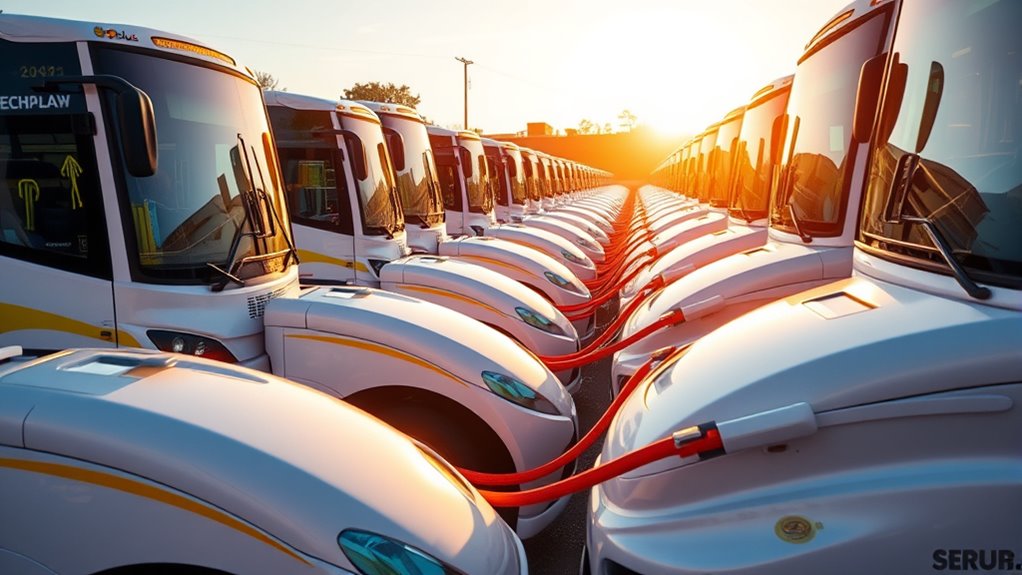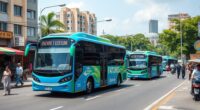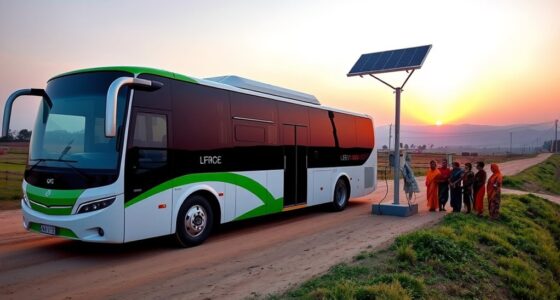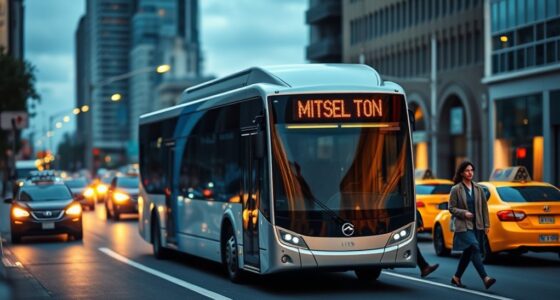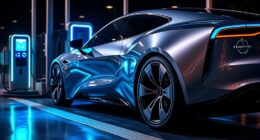School districts are switching to electric buses by leveraging federal funding, such as EPA’s $5 billion Clean School Bus Program, which helps replace diesel models with zero-emission vehicles. They’re gradually phasing out older diesel buses, investing in charging infrastructure, and updating maintenance skills to support new technology. As adoption grows, manufacturers increase production and tech improves. Stay with us to discover how these changes can transform your community and reduce pollution around schools.
Key Takeaways
- School districts are adopting electric buses through federal grants, primarily funded by EPA’s $5 billion Clean School Bus Program.
- Increasing manufacturer options and technological advancements improve bus range, reliability, and operational efficiency.
- Districts phase in electric buses gradually, investing in charging infrastructure and training maintenance staff.
- Environmental and health benefits, like reduced emissions and noise, motivate districts to switch from diesel models.
- Federal targets and commitments are accelerating the transition, aiming for most school buses to be electric by the 2030s.
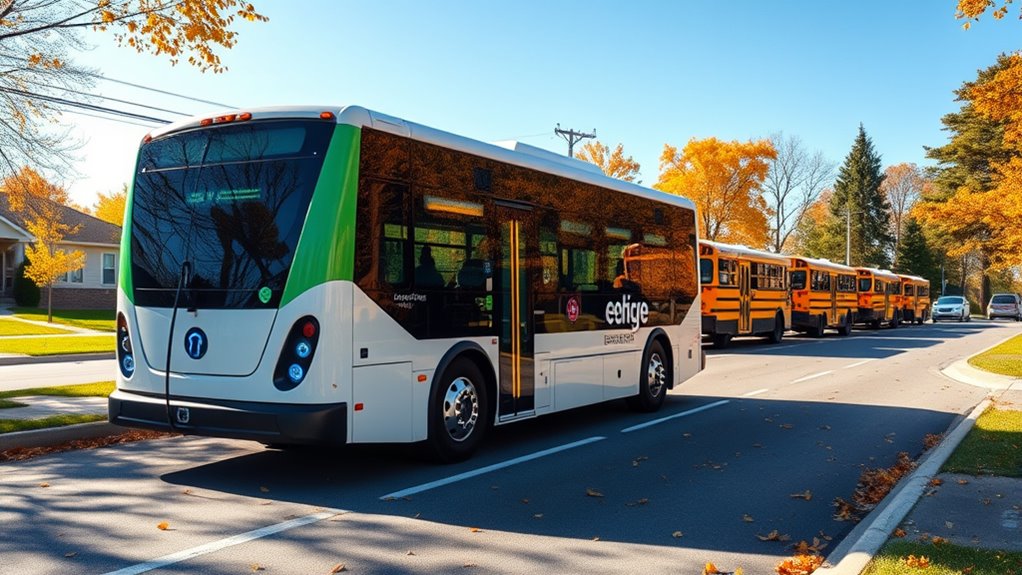
As school districts across the country accelerate their shift to cleaner transportation, electric school buses are becoming a common sight on roads and in neighborhoods. This transition is supported by the EPA’s $5 billion Clean School Bus Program, which funds efforts nationwide to replace traditional diesel buses with electric models.
Currently, over 3,400 electric school buses are operational or have been delivered across 48 states, serving more than 180,000 students daily. With nearly 6,000 buses committed by over 900 districts and operators, the momentum is clear.
Over 3,400 electric school buses serve 180,000 students daily across 48 states, with nearly 6,000 buses committed nationwide.
California leads the charge, with 661 electric buses already in service and over 2,000 more commitments, setting a benchmark for others to follow.
Some districts stand out for their bold investments. Twin Rivers USD, in Sacramento, operates 56 electric buses out of a total commitment of 84, demonstrating early adoption and commitment to cleaner fleets.
Los Angeles USD is making a significant impact with 253 commitments, including 56 buses already operational and 180 arriving by April 2025. These new buses will eliminate about 780,000 tons of CO₂ annually, markedly reducing the district’s carbon footprint.
LAUSD also expects to save around $10,000 per bus each year on fuel and maintenance costs. In fact, LAUSD recently passed a resolution to transition its entire fleet to electric, showing a strong commitment to sustainability and health.
Federal support has been crucial in driving this shift. Since 2022, three EPA funding rounds have allocated $3 billion to purchasing clean buses, with 90% of applicants favoring electric models over alternative fuels.
These grants have awarded over 8,500 buses, mostly electric, including support for tribal nations and districts serving high-need, low-income communities.
Despite representing only 2.5% of the entire school bus fleet, electric buses are growing rapidly—tripling from 1,828 in 2022 to nearly 6,000 in 2023. The expansion of electric buses is driven by increasing investments and advancements in battery technology.
Manufacturers are ramping up production, with new models like Proterra-powered buses hitting markets across Indiana and other states.
Switching to electric buses offers clear environmental and health benefits. Replacing diesel exhaust with zero-tailpipe emissions drastically cuts air pollution around schools and depots, reducing asthma risks and improving community health.
Electric drivetrains are more energy-efficient than diesel engines, and the potential for bidirectional charging could enhance energy resilience and grid stability. Furthermore, ongoing research into battery range limitations aims to improve the operational capabilities of electric buses in diverse weather and route conditions.
Additionally, electric buses operate more quietly, reducing noise pollution and fostering better neighborhood relations.
However, challenges remain. Higher upfront costs, the need for upgraded charging infrastructure, and battery range limitations, especially during extreme weather, pose hurdles. Advances in battery technology are essential to overcoming range limitations and ensuring reliable operation in diverse conditions.
Maintenance requires new skills and training for technicians, and route planning must adapt to charging needs.
Despite these obstacles, commitments continue to grow, with expectations that the market for electric school buses will double every 12 to 18 months.
Federal targets aim for a majority of school buses to be electric by the 2030s, aligning with broader climate goals and emphasizing the importance of equity, health, and sustainability in shaping the future of student transportation.
Frequently Asked Questions
What Is the Lifespan of an Electric School Bus?
You’re wondering about the lifespan of an electric school bus. Typically, these buses last about 12 to 15 years, similar to diesel models, with potential for up to 20 years in ideal conditions.
Proper maintenance and moderate climates help maximize their lifespan. Battery durability aligns with the bus frame, and while capacity decreases over time, the overall service life remains comparable.
This ensures predictable long-term planning and costs.
How Are Charging Stations Funded and Maintained?
Think of charging stations as the roots of your electric bus network—they need support to grow strong. Funding comes from federal grants, state incentives, private financing, and public-private partnerships.
Maintenance involves regular checks, energy costs, and staff training. Schools often use smart systems to optimize energy use.
With this support, your electric buses run smoothly, helping reduce emissions and save money long-term, just like a well-nurtured tree yields healthy fruit.
What Safety Features Do Electric Buses Include?
You’ll find electric buses equipped with numerous safety features. They include automatic disconnects that activate during crashes or system issues, fire prevention systems, and clear high-voltage cabling.
Battery packs are safeguarded against impacts, water, and thermal events, with barriers and robust casing. Advanced tech like thermal isolation, monitoring systems, and autonomous safety functions help prevent hazards.
Regular maintenance and safety training guarantee these features work effectively, keeping everyone safe on the road.
How Do Electric Buses Perform in Extreme Weather Conditions?
Imagine gliding smoothly through chilly mornings, feeling confident in your electric bus’s resilience. In extreme cold, your bus’s battery might lose some of its punch, reducing range by about a third at 25°F.
But you’ll notice better traction and stability compared to diesel. Preheating, route planning, and efficient heating help maintain performance.
Are There Subsidies or Financial Incentives for Switching?
You’ll find many financial incentives available for switching to electric buses. Federal programs cover up to 67% of costs, especially for low-income and rural districts, while tax credits can be used repeatedly until 2030.
State-specific grants, like California’s, and funds from the Volkswagen settlement also help.
Plus, the Bipartisan Infrastructure Law allocates billions for energy-efficient buses, making the switch more affordable and appealing.
Conclusion
As you watch school districts shift to electric buses, it’s like witnessing a new dawn breaking over a once-dull landscape. These changes aren’t just about replacing engines; they’re about lighting the way to cleaner air, lower costs, and a healthier future for students. Your district’s move is like planting a seed that will grow into a thriving forest of sustainability. Embrace this progression, and you’ll help steer the journey toward a brighter, greener tomorrow.
